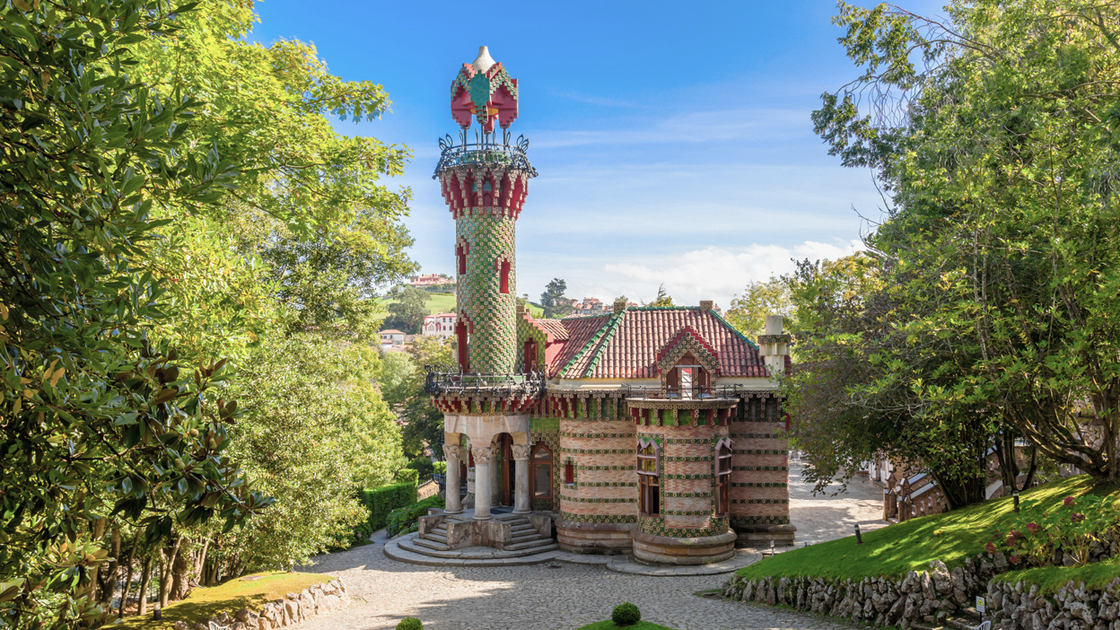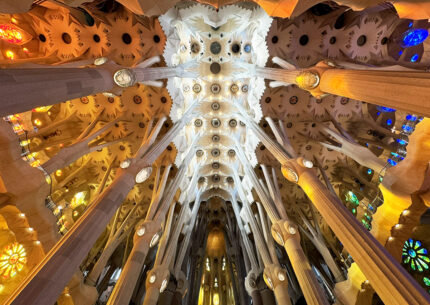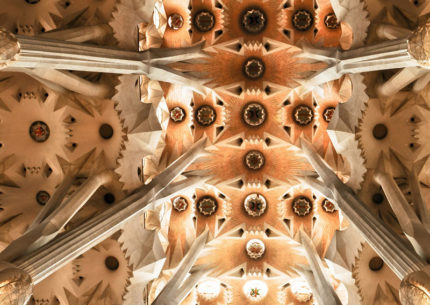
THE GREAT GAUDÍ IN THE SPANISH NORTH
The great gaudí in the spanish north Today we want to take you on a visit to Villa Quijano or el Capricho, designed by architect Antoni Gaudí in Comillas, a quiet little town in Cantabria.
This early work of Gaudí makes for a relaxing stop on a trip across the beautifully green northern Spain, with its gorgeous Atlantic beaches and the rugged Cantabrian Mountains.

Antoni Gaudí
The Catalan architect Antoni Gaudí (1852 – 1926) is today famous the world over, and is synonymous with the masterpieces of his maturity, such as the Sagrada Família, the Güell Park, the Pedrera and Batlló House.
Since Gaudí lived all his life in Catalonia, you can visit most of his works in and around Barcelona, best with a private tour by Unison Routes.
However, a selected number of Gaudí’s houses were built outside Catalonia, in northern Spain.
Of these, the Villa Quijano, nicknamed el Capricho (the Caprice in English), is by far the most famous.

A summer villa for a wealthy Indiano
In 1883, the very year when the then-young architect received the commission for the Sagrada Familia church, he also was asked by the wealthy Máximo Díaz de Quijano to design a villa for his holidays in Comillas.
Máximo Díaz de Quijano, born in Cantabria, was an Indiano, one of the Spaniards who had emigrated to Cuba and the Caribbean in the 19th century.
A fantasy in green, red and gold
The genius of Gaudí was the perfect tool to shape Díaz de Quijano’s desire for ostentation into an exuberant extravaganza of green, red and golden-yellow.
The architecture of the villa is highly eclectic and reminiscent of both Gothic and Spanish Islamic art, ranging from the Mudejar to the Nazarí styles.
The building’s roof, outer walls and smokestacks are amply decorated by green, red and yellow-gold ceramic tiling.
Underneath this colorful exuberance and the unconventional curved surfaces on the façade, there lies a skillful use of Euclidean geometry that adds to the beautiful harmony of the villa.
Nature in, nature out
In el Capricho we can find a great number of allusions to nature with vegetal and floral motifs, such as the sunflowers in the outside tiling of the building.
Like many others, he had prospered there and later chose to return to Spain. The summer villa he wanted had to reflect his increased social status.
Máximo Díaz de Quijano, after all, loved botany and even had a beautiful wooden greenhouse built for him, enveloped on three sides by the villa.

References to music
Always keen to reflect the interests of his clients, Gaudí decided that, besides decorating the el Capricho with elements related to nature, he would also add references to music both inside and outside the building.
Wrought iron violin clefts, sixteenth notes, guitar-playing bees on stained glass windows and more can be discovered by the careful visitor.
The building’s nickname itself immediately brings music to the forefront of the mind. Some may feel like wanting to listen straight away to Niccolò Paganini’s 24 Caprices for solo violin!
The Spanish royalty holidaying in Comillas
Díaz de Quijano was the brother-in-law of Antonio López, the Barcelona-based entrepreneur from Comillas who, in the last quarter of the 19th century, turned that small fishing village into a monumental summer resort.
For a time, Comillas was frequented by rich Catalan entrepreneurs, the aristocracy, and even the Spanish Royalty.
In the 1880s, Gaudí assisted senior architect Joan Martorell on the project of the summer residence in Comillas called Palacio de Sobrellano, property of Antonio López.
It was that same Joan Martorell who recommended Gaudí to Díaz de Quijano, acknowledging the ingenuity and creativity of the younger architect.

The beauty of Comillas and the Spanish north
Did you like this post? Would you like to know more about the beautiful and relatively little-known Spanish north?
Yes?
Leave your comments below!
Our thanks
To architect Rosa Saget for the photos of el Capricho and the Spanish north.




I have a vivid memory of the day when my professor of history of architecture presented Gaudi. She opened the door, she came into the classroom, moving slowly towards the desk. Wow. She opened a huge door in my mind and in my heart.
Beautiful post Francesco!
https://www.goodreads.com/book/show/326092.Gaudi
Very interesting information! Even for local people as me. I learn many questions here!
Visit “Capricho” when Paganini is in earphones can be great!
Thanks Francesco for this beautiful post. The Caprices music by Paganini elevated my reading and experience. I love Antoni Gaudi’s work in Barcelona especially the Sagrada Familia. Now I will need to go to Comillas to check out Villa Quijano.
Thank you Francesco for letting us dreaming of Spain during this tough time.
Excellent & intriguing